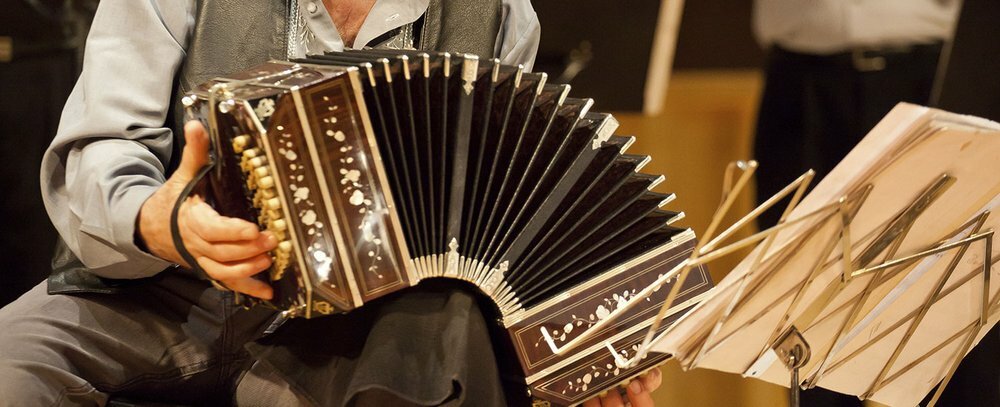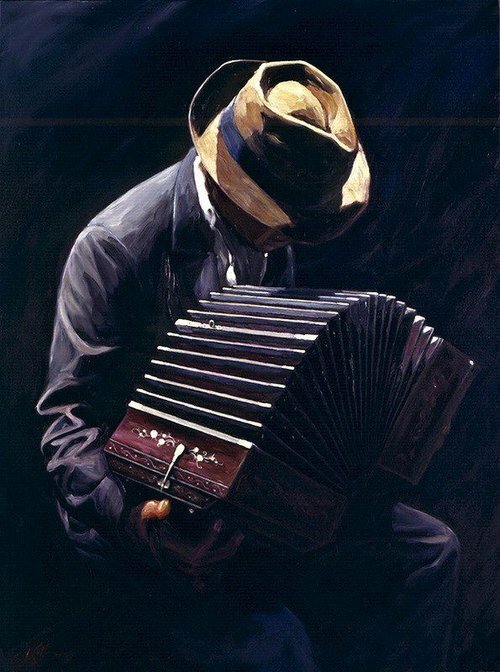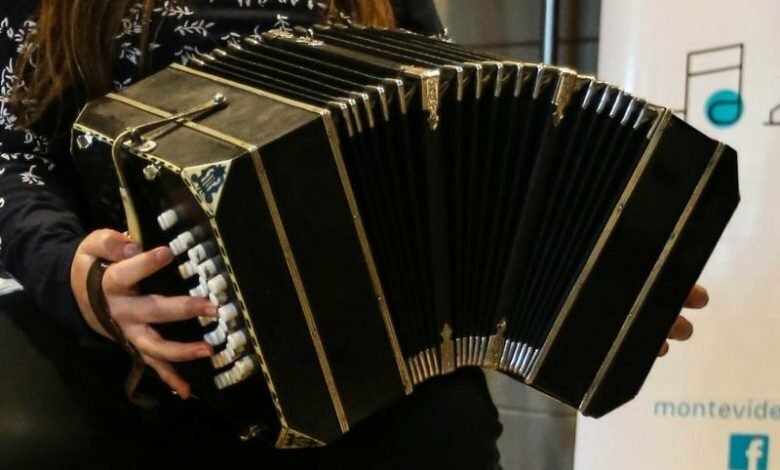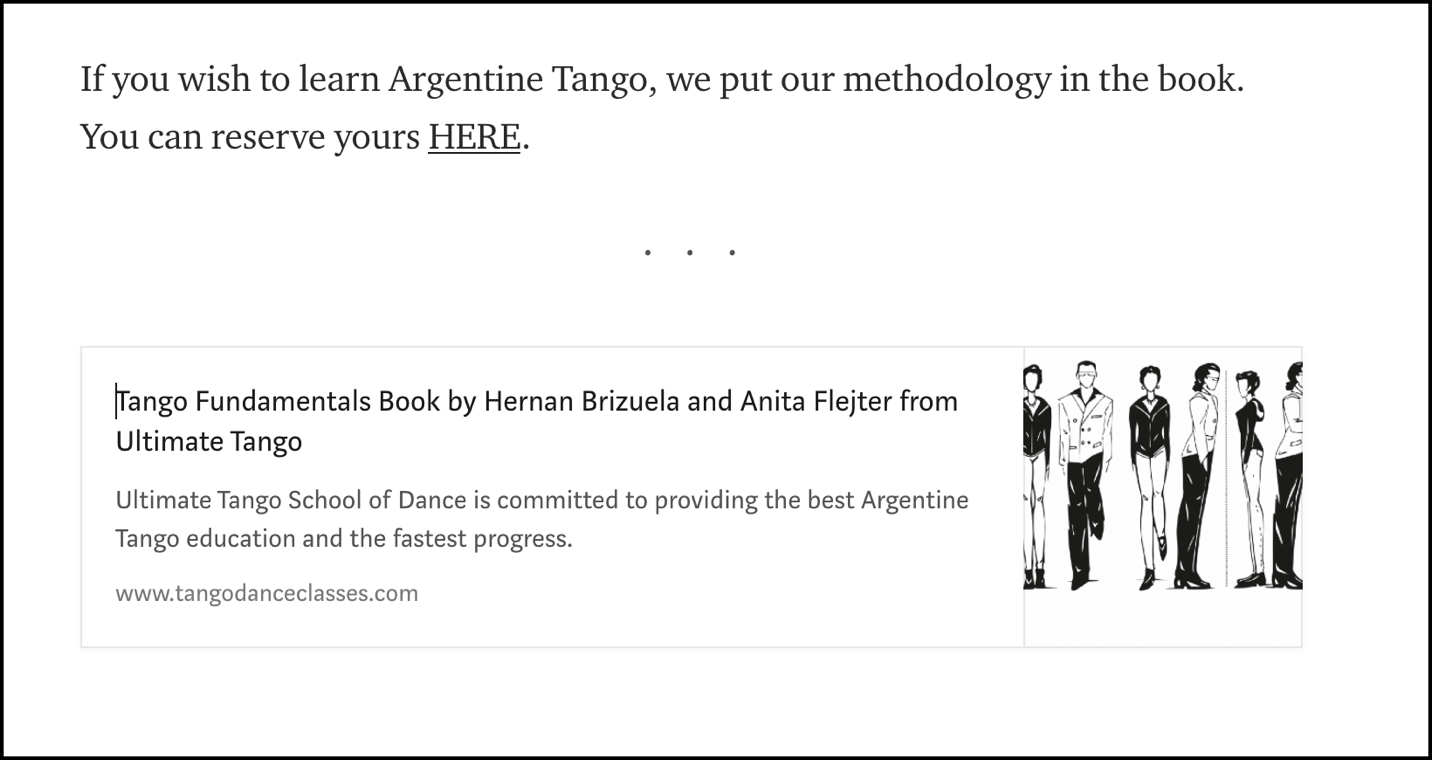Those who dance the Argentine tango know that there's more to this passionate dance than just its movements. One signature element that makes tango distinct from other dances is its music.
Even without knowledge of what the lyrics mean, one will immediately recognize its emotional qualities, thanks in large part to the bandoneon, which has been hailed as the soul of tango music.

The History of the Bandoneon
According to a post from the Los Angeles Tango Academy,
“The bandoneon is a large, rather complicated concertina originally developed in Germany for churches that could not afford organs.”
Further to the bandoneon, a paper titled A New Body for a New Tango: The Ergonomics of Bandoneon Performance in Astor Piazzolla's Music describes the instrument in technical terms: “The bandoneon belongs to the category of intermittent aerophones, specified as free-reed instruments with hand-operated bellows (Dunkel 1993:19). The development of free-reed technology in the early 1800s created possibilities for the invention of new musical instruments.”
When looking at bandoneon history, it is easy for one to see that the instrument had only been a few decades old before Argentine tango started being danced by the porteños in Buenos Aires.
The instrument’s novelty at the time was perhaps one of the factors that endeared it to tango musicians and composers, aside from its musical qualities.
Surprisingly, though, the bandoneon is hardly a simple instrument to master.
In fact, according to a post from BBC, “a typical bandoneon contains more than 2,300 parts” and has 71 buttons — 38 for the right hand and 33 for the left — that generate the notes and chords.
The article also states that the bandoneon was invented by Heinrich Band, a German instrument-maker in the 1850s. The name given to the instrument is a composite of Mr. Band’s surname and the German word for accordion.
To play the instrument, one must use both hands to push and pull the air through its bellows.
This is what produces its nostalgic, lamenting sounds that tended to resonate with many of the immigrants in Buenos Aires.
Further to the bandoneon’s features, Dance Facts states:
“The most common type of bandoneon that is used in tango music (either in smaller or larger bands) uses a 71 button format, which can produce two sounds for each button depending on whether the bellows is expanding or contracting.”
“Tango bandoneon keyboard is based on the standardized layout known as ‘Rheinische Lage’ introduced by German instrument makers in the 19th century, but with the added presence of six additional buttons that are used almost exclusively by tango musicians. This enhanced layout bears a close resemblance to those found in German or Anglo concertina instruments.”
“As for the range of tango bandoneon, it covers just under five octaves from the C two octaves below middle C, thus enabling tango musicians to easily play all tango melodies.”
According to posts from Los Angeles Tango Academy and Dance Facts, the bandoneon was brought to Argentine shores by German and Italian immigrants around 1870. This was a decade after Band’s death, and it was around this time that the bandoneon began to gain a firm foothold in places like Buenos Aires and Montevideo.
Tango was considered an early genre of music during these years, but the bandoneon had already become an essential instrument for the dance.
With its strong but sorrowful resonance, the bandoneon became the soul of tango, which had evolved from numerous musical influences in Argentina and Uruguay, primarily the folk style of the milonga.
Though it was a German-made instrument, the bandoneon was produced primarily for Argentine and Uruguayan markets by 1910. In 1930, as much as 25,000 bandoneons were being shipped to Argentina alone. However, because of World War II and the decline in demand, the mass-production of bandoneons by German manufacturers came to an end.

Sound and Soul
Though the bandoneon has a distinct sound, many people often mistake it for the accordion. However,
the bandoneon is instead closer to a concertina, which looks like a smaller, simpler version of the bandoneon.
This video from Julian Rowlands, a bandoneon player from the UK, sheds light on the bandoneon versus accordion debate by demonstrating how each instrument is played and what makes them different from each other.
One distinct difference he shows is that
the bandoneon can produce a percussive sound when it is played by bringing it down into one’s lap.
The accordion, on the other hand, can’t be played using this method because of its much bulkier size. Often, this percussive sound produced by a bandoneon being brought down to one’s lap is used for the arrastre and serves as somewhat of a signal to the dancers to anticipate another note.

Tango Project Loca Bohemia further explains the differences between bandoneon and accordion:
“In contrast to the accordion, the bandoneon has no predefined chords. It has no piano-like keyboard. It’s a complex layout of buttons, which varies from instrument to instrument. An average is 37 buttons on the right hand and 33 on the left hand. It is played resting the instrument on both knees while sitting, opening (abriendo) and closing (cerrando) while depressing one or more buttons with each hand. Most buttons make a different tone opening and closing, although there is no pattern to the layout.”

Beyond its technicalities, what has truly cemented the bandoneon as a perfect instrument for Argentine tango is its melancholy sound. Often,
the sound of the bandoneon in Argentine tango is described as or compared to that of a crying instrument. It aptly symbolizes many of the themes highlighted in tango songs, such as heartbreak, homesickness, and loneliness.
A post from Tanguito, Argentine Academy in London gives an example of a song — Sollozo de bandoneon — that directly references the bandoneon’s sorrowful musical qualities:
Ven a bailar que quiero hablarte
aparte de tus amigas.
Quiero que escuches mi fracaso
y que en mis brazos el tango sigas.
Después de un año vuelvo a hablarte
y al verte me pongo triste.
Porque esta noche he de contarte
que por perderte sufro de amor.
Quien sufre por amor comprende este dolor,
este dolor que nos embarga.
Quien sufre por amor comprenderá el dolor
que viene a herir como una daga.
Te tuve y te perdí,
y yo que soy sin ti.
Quien sufre por amor comprenderá mejor
por qué solloza el bandoneón.
Con su gemir de corazones,
los bandoneones lloran su pena,
igual que yo sollozan ellos.
Porque en sus notas hay amores
y por amores hoy sufro yo.
Come and dance, I want to talk to you
away from your girlfriends,
I want you to listen to how I have failed,
and to stay in my arms for a tango.
It’s been a year since we last spoke,
and seeing you makes me sad.
Tonight I have to tell you
that I am lovesick from losing you.
Whoever suffers for love understands this pain,
this pain that overwhelms us.
Whoever suffers for love will understand the pain
that hurts like a dagger.
I had you and I lost you,
who am I without you?
Whoever suffers for love will understand better
why the bandoneon sobs.
Groaning like hearts do,
bandoneons cry their pain,
like me, they’re sobbing too.
Because in their notes, there are loves,
and because of love, today, I suffer too.
The same post further explains:
“Most tango songs either express the emotions of the heartbroken poet or try to explain why he’s been abandoned. Some songs are quite direct, others use metaphors to express the poet’s emotions.
Sollozo de bandoneon does both: the poet expresses his own emotions directly (“Tonight I have to tell you that I am lovesick from losing you”) and also lets the bandoneon express some of his personal feelings.”
Thus, it is no surprise that the bandoneon became the signature instrument of tango music.
Even after mass production for the bandoneon ceased, tango musicians continued to use the instrument to play. As tango itself underwent a lull and an eventual resurgence in the ‘80s and ‘90s, the bandoneon also experienced the same revival.
Some groups are even attempting to replicate the old manufacturing practices for the bandoneon to begin making more of the instrument for wider appreciation and distribution.
Troilo and Piazzolla: Masters of the Bandoneon
The bandoneon’s melodious but sorrowful sound became most prominent in the hands of Anibal Troilo and Astor Piazzolla, both of whom were masters of manipulating this complex instrument.
Having lived in the years that Argentine tango was in its heyday, both maestros made significant contributions to tango music.
The Min-On Concert Association explains:
“A tango orchestra typically consists of bandoneons, violins, piano and double bass, in addition to guitar and drums, accompanied by singers and dancers of the tango tradition. Among these instruments, the bandoneon is perhaps the most key instrument in producing the authentic, emotional and nostalgic sound of tango.
“[I]n the mid-20th century, beginning with Aníbal Troilo — a leading proponent of the bandoneon and one of the greatest masters of it — a number of notable bandoneonists made a sudden appearance on the tango scene. They developed zealous and sophisticated techniques, creating the ‘Golden Age’ of tango with their unique modern tango compositions. Thus, the bandoneon became the ultimate instrument exemplifying the distinctive voice and soul of tango.”
Troilo in particular was so popular that when the staff and students at the department of industrial design at the National University of Lanus in Buenos Aires undertook a recent project to build new bandoneons, they named it after Troilo. A report from BBC states:
“To help design and build the new instrument, the 14 members of the project team got their hands on one of the most celebrated bandoneons, one made by German craftsman Alfred Arnold, considered to be the Stradivarius of bandoneons.
They have called it the ‘pichuco,’ which in English means ‘cry baby’, and was the nickname of Anibal Troilo, Argentina's most famous bandoneon player.”
Astor Piazzolla, on the other hand, was also a prominent bandoneonist and is often associated with the concept of Nuevo Tango (New Tango), even before the Nuevo Tango movement pioneered by Gustavo Naveira and his peers. Piazzolla’s Nuevo Tango focused more on the dance’s musicality as opposed to the research done by Naveira and company, which provided a structure that would help teach tango figures to students in a more systematized manner.
An article from the Los Angeles Times provides a brief background on Piazzolla in his early days as a bandoneonist:
“Piazzolla became the visionary who revolutionized the tango — that doleful mélange of broken hearts, dirty dancing and soul-crushing melancholy developed in the South American immigrant melting pot of Argentina and Uruguay. [...]
He improbably caught the eye of Carlos Gardel, the baritone-voiced mega-star of the tango who was making films in New York with Paramount after a cabaret run in Paris.
“Gardel even invited the 14-year-old Astor to accompany him on tour, but the family decided he was too young. It was a fortuitous decision. The 1935 tour ended in catastrophe when Gardel, 44, and his entire entourage were killed in an airplane crash in Medellín, Colombia, a cultural apocalypse that sent the tango universe into profound mourning. [...] Astor, then 15, talked his way into bands and soon moved to Buenos Aires, a prodigy playing with some of the era’s best-known ensembles, notably the orchestra of the legendary Anibal Troilo.”
This year, Piazzolla celebrates his centenary, and though he passed away in 1992 at the age of 71, his life and memory remain associated with his work as a master of the bandoneon.

Complex as this instrument may be, the bandoneon has given tango the “voice” it needed to embody the hearts of many dancers and composers.
Though many of the existing bandoneons are already considered vintage, the story of the bandoneon will never cease to be told. In the same breath, it will never stop telling its own stories through tango.
If you wish to learn Argentine Tango, we put our methodology in the book. You can reserve yours HERE.

